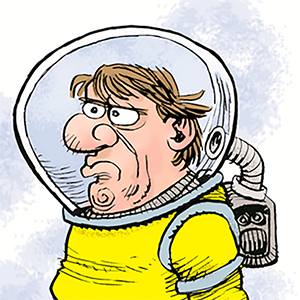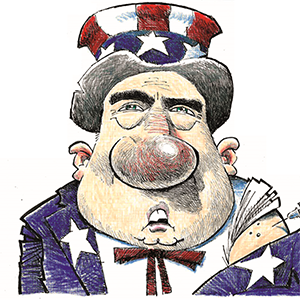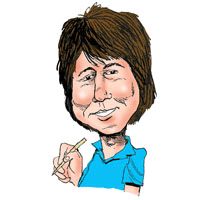Mary McNamara: Fire is part of LA's ethos. But this Angeleno is asking, 'Is it time to go?'
Published in Op Eds
"Is it time to go?"
That's the question my husband and I have been asking ourselves with traumatic regularity over the past seven days. As we watched the Eaton fire erupt in nearby Altadena, we wondered. When we got the evacuation warning alert, we answered: We packed the car, took a few additional minutes to scoop up some photo albums and left.
After the warning and nearby mandatory evacuations were lifted in our area on Saturday, we returned home. Our power went out on Sunday and when neighbors received texts saying it would be out until Wednesday, we asked the question again — we hadn't bothered to unpack the cars. Then the lights went on and we figured we'd stay. On Monday, we woke again to high winds and a "particularly dangerous situation" alert from the National Weather Service.
Compared with thousands of people living in the Los Angeles area, we are incredibly lucky. And we feel that. But we're also exhausted and, with the winds blowing hard even as I write, on edge. Now the question has become bigger and more demanding.
Is it time to go … forever? To leave, if not California then the foothills, which we have called home for 21 years?
A year or two after I moved to L.A. the Old Topanga fire of 1993 swept through Malibu, creating scenes of desperate escape and destruction similar to, if more limited than, those we've seen from Altadena and the Palisades. I remember at the time people darkly joking that "Malibu" was a Native American term for "Do not live here."
Altadena also burned that year, once in a brush fire that killed two firefighters, again in a wildfire that destroyed or damaged 40 homes. But it was after Old Topanga that revered California writer, activist and historian Mike Davis wrote his famous essay, "The Case for Letting Malibu Burn," in which he argued, among other things, that Los Angeles had already paid too high a price for allowing rich people seeking seclusion, beauty and exclusivity to build in places historically prone to fire.
Now I look at the mountains that rear up around my community of La Crescenta, beautiful hills that, depending on the time of year and amount of rainfall, can make you feel like you're in Ireland or Scotland. And I wonder: Should we be living here?
Just two years ago, they were covered with snow; a few weeks ago, fog crept down, as it often does. On Sunday, while the Eaton fires still raged, they sat serene and seemingly untouchable against a bright blue sky, the air so clear you would never know a horrific fire continued to burn just miles away.
But I know it's a mirage. The winds can change that in a hour; an arsonist or accidental spark in less than a minute. During the 2009 Station fire, flames were visible on the hills as we evacuated. At more than 160,000 acres, it remains the largest wildfire in Los Angeles County history, claiming the lives of two firefighters and destroying 89 homes.
The January 2025 fires will be remembered for far more widespread destruction of property. With at least 24 people dead and more than 12,000 structures destroyed, the Eaton and Palisades fires are among the worst in modern history — and they are still burning.
Angelenos take pride in their resilience. For many, fires (like floods or earthquakes) are the price one pays for living in paradise.
But with climate change forcing Southern California into a maddening cycle of deluge and drought, people are beginning to question the wisdom of building, or rebuilding, communities that edge up to the more wilder areas of L.A.'s varied topography. Davis' essay is once again being quoted, directly and in subtext, as officials, experts, historians and randos on Reddit discuss the sustainability of Southern Californians living so close to hills and mountains where fire regularly breaks out.
Davis wasn't talking about Altadena, or the foothills, where fire has been far more rare than in Topanga and Malibu. But still, if I step out of my house, I can see hills covered with dried-out brush and the tops of power stations. And I wonder.
Not that we live in an urban wilderness. We live in what is known as a developed tract, dominated by the wide streets and cheek-by-jowl midcentury homes designed by Webster Wiley. There are street lights and sidewalks; a park and a half-dozen schools lie within walking distance.
Neither did we come seeking privacy, exclusivity or even beauty, at least of the wild sort. We bought here because of the fine school district, the ease of commute to The Times, which was then downtown, and the general affordability. Down the hill in Montrose, Honolulu Boulevard is such a lively and classic small-town main street that it shows up in countless TV series and films.
Yes, as we drive up the streets that lead to our home, we dip under bowers of California oaks, see deer, bobcats and the occasional bear, but as in Altadena, there's nothing exclusive about this part of the world and we still felt part of the metropolis; on a clear day, you can see most of downtown.
My husband and I love our home, where we have experienced most of our marriage and raised our three children. Watching as people, including friends and colleagues, post pictures of the smoldering ruins of equally beloved homes, our hearts break. But they also fill with fear. It could so easily be us. Next time, or even this time.
A house is just a house, compared with human lives. But our house is the only thing of real value that we own. (Mostly; there is still a mortgage.) It is what allowed my husband to (finally) retire at 72 and, barring some unexpected windfall, it is the only inheritance our children will have. We have fire insurance, for now, though given the recent history of that industry, our premiums could be raised to unsustainable levels or our coverage dropped altogether. And then what?
If we are fortunate and the house continues to survive this interminable fire season, we could comfort ourselves with the uniqueness of these ghastly circumstances — the 85-plus-mph "mountain wave" winds, the heavy rains in early spring followed by unusual dryness. This is not Malibu, after all. How often could such a horrific confluence of events occur?
Too often in recent years and no doubt more often in the future. Climate change is real and it is flooding, burning, battering and desiccating California, the country and the world on a daily basis. And not just in places prone to catastrophe.
Scientists warn, too many politicians ignore and the rest of us are forced to evacuate, to mourn friends and family, to gape at the wreckage of where we once lived.
I have railed, and will continue to rail, against those who refuse to quickly and resolutely address the environmental issues that threaten all life on this planet. But right now, as I check in with The Times' excellent fire coverage and regularly tap into Watch Duty to see if the Eaton fire is on the move again, my husband and I look up at the hills and ask each other: "Is it time to go?"
Are the mountains that have delighted and inspired us for so many years now a threat? Will the eucalyptus in the corner of our yard be our undoing? Or the pine trees that tower around our neighborhood?
We have already gotten rid of our lawn, put in gravel and succulents, taken down two trees that had grown uncomfortably close to our house. But we still have roses and lavender, jasmine and ivy. We felt we had to plant two smaller trees to replace the ones we killed. Now they've grown and their drying leaves rattle in the wind. Was that a mistake? Is being here at all a miscalculation?
We are exhausted, we are anxious and the Santa Anas are blowing, which can shred reasonable thought even without extreme fire risk. With so many in real crisis, it's hardly the time for the existential variety. There are thousands in critical need; contemplating what could happen is a luxury when so many must cope with what already has.
Nevertheless, the city, county and state will have to face tough questions and make hard choices once the fires are out. How do we prevent such a catastrophe from happening again? Can we?
Homes, businesses and lives will be rebuilt, but how and where?
Our car remains packed as we squint out at the hills. For now, we can only pray and await further instruction.
©2025 Los Angeles Times. Visit at latimes.com. Distributed by Tribune Content Agency, LLC.




























































Comments